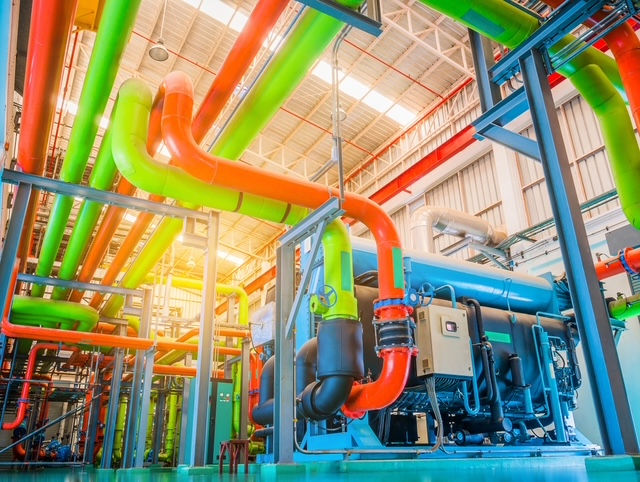Understanding Dew-Point Control vs. Dry-Bulb Control in Mission-Critical Humidity Management
- Jill Nelson
- Jul 14
- 4 min read
Updated: Jul 15

Humidity control in commercial, industrial, and institutional facilities involves more than simply maintaining comfortable temperature conditions. Two fundamental approaches dominate the field: traditional dry-bulb control and the increasingly adopted dew-point control method. Understanding the technical differences between these approaches is essential for facility managers and engineers working with mission-critical environments.
Dry-Bulb Control: The Traditional Approach
Dry-bulb control is the conventional HVAC strategy that most facility managers are familiar with. This method focuses on maintaining specific air temperatures using standard thermostats and temperature sensors. The "dry-bulb" temperature refers to the ambient air temperature measured by a regular thermometer, without accounting for humidity effects.
In humidity control applications, dry-bulb systems typically operate by cooling air below the desired temperature to remove moisture, then reheating it to achieve the target temperature and relative humidity combination. This approach works adequately for basic comfort applications where precise humidity control isn't critical.
The primary limitation of dry-bulb control lies in its indirect relationship to actual moisture content. The system responds to temperature changes but doesn't directly measure or control the absolute amount of water vapor in the air. This can result in humidity fluctuations as ambient conditions change throughout the day.
Dew-Point Control: Precision Moisture Management
Dew-point control measures and maintains the temperature at which water vapor in the air begins to condense into liquid water. This temperature represents the absolute moisture content of the air, regardless of the actual air temperature.
Unlike relative humidity, which changes as temperature fluctuates, dew-point temperature remains constant for a given amount of moisture in the air. For example, air with a 50°F dew-point contains the same amount of moisture whether the actual air temperature is 70°F or 80°F.
This absolute measurement provides more predictable and consistent humidity control, which is particularly important in critical environments where moisture levels directly affect processes, equipment, or stored materials.
Technical Advantages of Dew-Point Control
Consistent Moisture Levels: Dew-point control maintains constant absolute humidity regardless of temperature variations. When a system maintains a 50°F dew-point, the moisture content remains stable even as dry-bulb temperatures fluctuate due to varying heat loads, occupancy, or external conditions.
Energy Efficiency: These systems typically consume less energy by eliminating the inefficient cool-and-reheat cycle common in traditional approaches. Rather than overcooling air to remove moisture and then reheating it, dew-point systems can maintain proper moisture levels while operating at higher, more efficient temperatures.
Predictable Process Control: Industries where humidity affects product quality benefit from the consistent conditions that dew-point control provides. Manufacturing processes involving hygroscopic materials, precision assembly, or chemical reactions often require stable moisture levels that don't vary with temperature changes.
Condensation Prevention: By maintaining specific dew-point temperatures, these systems minimize condensation risk on equipment surfaces, products, or building components.
Applications Requiring Precision Humidity Control
Clean Rooms and Laboratories: These environments require precise humidity control to prevent static electricity, maintain sterile conditions, and ensure accurate test results.
Pharmaceutical Manufacturing: Pharma facilities require stringent environmental controls to meet FDA validation requirements and ensure product quality. Active pharmaceutical ingredients (APIs) and finished dosage forms are often hygroscopic, making consistent moisture control critical for potency, stability, and shelf life. Dew-point control helps maintain compliance with GMP standards.
Healthcare Facilities: Hospitals, surgical suites, and other healthcare facilities require precise humidity control for infection control, equipment protection, and patient safety. Operating rooms need consistent conditions to prevent static discharge near sensitive medical electronics, while pharmaceutical compounding areas require stable humidity for drug preparation and storage.
Data Centers: Server rooms and data centers need consistent moisture control to prevent condensation on sensitive electronic equipment while maintaining optimal operating conditions. With increasing equipment density and heat loads, precise humidity control has become more critical.
Manufacturing Facilities: Industries processing moisture-sensitive materials require consistent humidity levels. Electronics manufacturing, food processing, textile production, and specialty chemical processing all benefit from stable moisture conditions.
Storage and Warehousing: Facilities storing pharmaceuticals, electronics, documents, or other moisture-sensitive materials need consistent humidity control to prevent damage while maintaining energy efficiency.
System Implementation Considerations
Dew-point control systems incorporate specialized sensors that directly measure moisture content, advanced control algorithms, and often integrate desiccant dehumidification systems. The control strategy typically involves measuring return air dew-point temperature and modulating dehumidification equipment accordingly.
Implementation may involve controlling chilled water temperature, refrigerant flow, or desiccant wheel speed through building automation systems. The sophistication of these systems requires more complex installation and maintenance compared to basic dry-bulb control.
When Each Approach Makes Sense
Dry-bulb control remains appropriate for many applications. Standard office buildings, retail spaces, and other comfort-focused environments often function well with traditional systems, which are simpler to install, operate, and maintain.
Dew-point control becomes valuable when:
Process requirements demand consistent moisture levels
Equipment sensitivity to humidity fluctuations is high
Energy efficiency optimization is important
Condensation prevention is critical
Regulatory compliance requires precise environmental control
Expert Selection, Implementation, and Service
Selecting and implementing the appropriate humidity control strategy requires a deep understanding of both the technology and the specific application requirements. At MSC, our expertise in mission-critical HVAC systems, combined with our specialization in process cooling and building automation, enables us to design, optimize, and maintain systems that deliver the precision and reliability that facilities demand. Our experience with dew-point control implementation across diverse industries ensures that humidity control strategies align with advanced operational requirements and long-term facility goals.




Comments